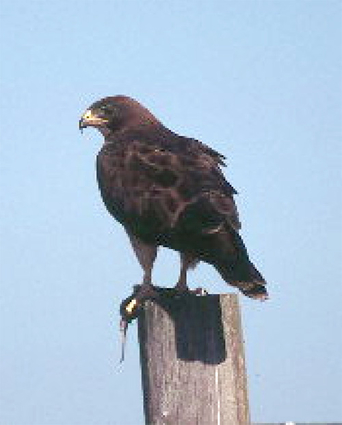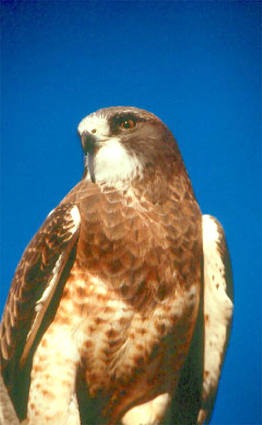The red-tailed hawk knows when it pays to sit down on the job
By Jessie Coty
A red-tailed hawk ( Buteo jamaicensis ) sitting placidly on a short post or low branch at the Lab? This common sight doesn’t match this large hawk’s reputation as a fearsome predator with sharp talons and a predilection for swooping down from great heights to grab small mammals before climbing at a steep angle back into the sky. C’mon, sitting down while on its predator job?
The hunt is not all special effects and stunts
While it’s true that the red-tailed hawk may pursue its prey at high speeds, impressive heights and with an acrobatic agility, the red-tailed hawk generally just simply hunts from a perch — a roadside utility line or a fence top. Although not the bird-of-prey (raptor) stereotype, this hunting method provides a plethora of small rodents, reptiles and birds. While it hunts across diverse habitats and a range of altitudes, these habitats nearly always include open areas with perches. With this perspective, an urban park is similar to a remote grassland set high in the mountains: both habitats, although vastly different, have perches which the hawk will use to sit on the job and seek prey. Yet, true to its fearsome hunter image, when it strikes its prey, it hits from above with all toes (and talons) extended and with undeniable force.
Commonplace yet anything but ordinary
Although the most common and widespread hawk in North America, the red-tailed hawk’s appearance is striking. It is typically identified by its broad red tail, light auburn to deep brown plumage and paler chest. With its long, broad wings folded, it’s difficult to see its four-foot wingspan. Yet its stocky, large body makes its size clear. A hooked beak and sharp talons give credence to its bird-of-prey distinction. It is simple to imagine that grasping, holding and killing its prey is all easily done in a day’s work. Common to many raptors, males yield the size advantage to females, yet does this 25 percent differential matter to its prey?
Movie "stuntbird" or just another day in hawk courtship?
While death-defying feats seem somewhat beyond the duty of courtship, that’s not the case for monogamous red-tailed hawks. The courting display consists of the pair soaring and circling widely, high above the ground. The male will then dive steeply downward and climb steeply back up again. This repetitive courtship display may eventually move into the pair grabbing each other, interlocking talons and spiraling toward the ground. Mating occurs more sedately (and safely), on a perch.
Nests may be nearly three feet in diameter and height. Chicks learn to fly and hunt over a period of about 10 weeks before becoming fully independent. Learning to fly from nests as high as 60 feet is impressive. Although most red-tailed hawks do not survive their first few years, those that do may live two decades or slightly more. Active during the day, you may see aerial displays as males aggressively defend their territories (steep dive or undulating flight) or you may hear its characteristic raspy, scraping "scream." Many movies that include a raptor soundtrack use this red-tailed hawk call, regardless of the geographic setting or bird species.
Lab bird feeders: instant meal for a hawk
Next time a red-tailed hawk is sitting and waiting quietly on a post near your building, look for a nearby bird feeder. Although it may seem the hawk has a watchful eye on a ground squirrel, it may stealthily be appraising those full-bellied songbirds enjoying a (last) meal at the feeder.






